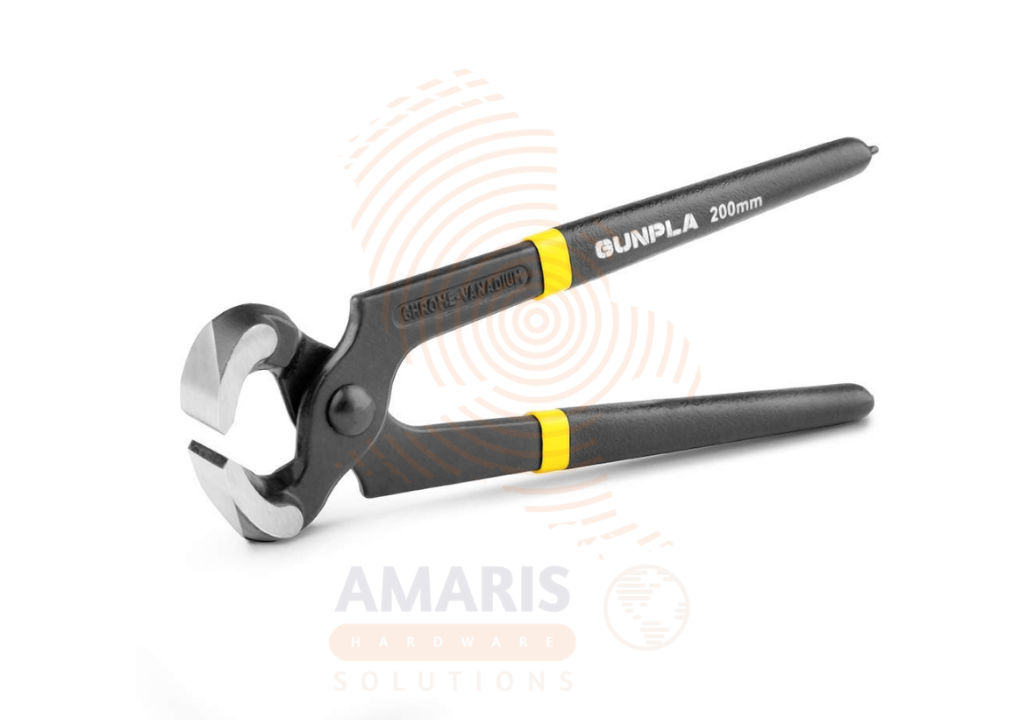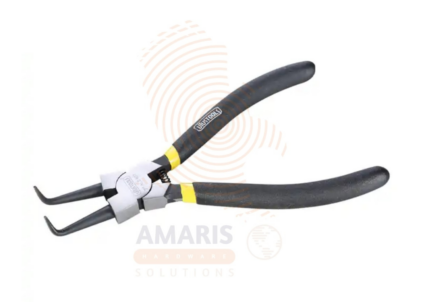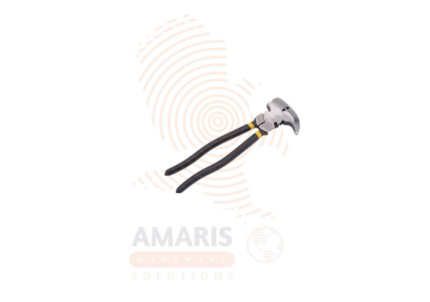Carpenter’s Pincers
$17.54 Original price was: $17.54.$16.66Current price is: $16.66.
WhatsApp Order
Carpenter’s pincers, also known as end-cutting pliers or end nippers, are a type of hand tool used in carpentry and woodworking. They typically have sharp, pointed jaws that come together in a cutting edge at the tips. These pincers are designed for gripping, cutting, and pulling materials such as nails, wires, or small objects in woodworking applications. The jaws are angled to provide leverage and facilitate precise cutting or gripping in tight spaces. Carpenter’s pincers are a versatile tool commonly found in a carpenter’s toolkit for various tasks related to shaping and assembling wood.
Description
Table of Contents
ToggleCarpenter’s Pincers
Uses
-
Nail Removal:
-
Carpenter’s pincers are effective for pulling out nails from wood surfaces. The sharp jaws can grip the nail securely, and the leverage provided by the tool facilitates easier extraction.
-
-
Wire Cutting:
-
These pincers are useful for cutting wires, especially in situations where a more robust cutting tool may not be as maneuverable. They can handle various gauges of wire commonly used in carpentry.
-
-
Trimming and Shaping:
-
Carpenters use pincers to trim and shape wooden pieces. The tool allows for precise cutting and nibbling away excess material to achieve the desired shape or size.
-
-
Gripping and Holding:
-
The jaws of carpenter’s pincers are designed to provide a firm grip on small objects or materials. This is helpful when holding pieces in place during assembly or when working with intricate woodworking tasks.
-
-
Cutting Small Gauge Metal:
-
Apart from wires, carpenter’s pincers can be employed for cutting small gauge metal materials, offering a quick and convenient solution for tasks involving lightweight metals.
-
-
Precision Cutting:
-
The pointed jaws of the pincers allow for precision cutting in tight spaces, making them suitable for fine detail work or when access is limited.
-
-
Versatile Applications:
-
Carpenters often find these pincers useful in various situations where a combination of gripping and cutting is required. Their versatility makes them a valuable addition to a carpenter’s toolbox.
-
-
Construction and Framing:
-
-
In construction and framing work, carpenter’s pincers can be used for tasks such as cutting and shaping small pieces of wood, as well as handling nails or wires commonly encountered in these applications.
-
-
Emergency Repairs:
-
-
Carpenters may use pincers for on-the-spot repairs, especially when other dedicated tools are not readily available. The tool’s compact size and versatility make it a handy option in emergency situations.
-
SAFETY HANDLING PRECAUTIONS
Safety Precautions
-
Personal Protective Equipment (PPE):
-
Wear appropriate PPE, including safety glasses or goggles to protect your eyes from flying debris or sharp objects.
-
-
Inspect the Tool:
-
Before use, inspect the carpenter's pincers for any damage, such as bent or broken jaws, loose joints, or worn-out handles. Do not use a damaged tool; replace or repair it as needed.
-
-
Secure Workpiece:
-
Ensure that the workpiece is securely held or clamped in place. This prevents slipping or unexpected movements that could lead to accidents.
-
-
Correct Tool for the Task:
-
Use the carpenter's pincers only for their intended purpose, such as cutting wires, nails, or small materials. Avoid using them on materials that may exceed their cutting capacity.
-
-
Proper Grip:
-
Hold the pincers with a firm and comfortable grip. Ensure that your hand is not in the path of the cutting jaws to avoid accidental injuries.
-
-
Positioning:
-
Position yourself in a way that allows for proper leverage and control while using the pincers. Avoid awkward angles that may compromise your balance or control.
-
-
Use Two Hands if Necessary:
-
For tasks requiring more force or precision, use both hands on the handles to maximize control and minimize the risk of slippage.
-
-
Keep Hands Clear:
-
Keep your hands and fingers away from the jaws while cutting or gripping. Always maintain a safe distance to prevent accidental pinching or cutting.
-
-
Cut Away from the Body:
-
When cutting materials, direct the cutting action away from your body. This reduces the risk of injury if the tool slips or if the material being cut breaks unexpectedly.
-
-
Store Safely:
-
When not in use, store the carpenter's pincers in a safe and designated location. Avoid leaving them in areas where they can be easily tripped over or damaged.
-
-
Training:
-
Ensure that individuals using carpenter's pincers are trained on their proper use and safety guidelines. This is especially important for beginners or those unfamiliar with the tool.
-
-
Awareness of Surroundings:
-
Be aware of your surroundings and the presence of others in the work area. Communicate effectively with colleagues to avoid accidental collisions or disruptions.
-
Related products
Bi-Metal Hole Saw Set
A 9 PCS Bi-Metal Hole Saw Set refers to a collection of nine hole saws, each constructed with a bi-metal design. A hole saw is a cylindrical cutting tool used to create holes in various materials such as wood, metal, plastic, and more. The term "bi-metal" indicates that the hole saws are made from two different types of metals, typically high-speed steel (HSS) and a more durable alloy like cobalt. This combination enhances the hole saw's cutting performance, making it suitable for a wide range of applications and providing increased durability and longevity. The set typically includes hole saws of different sizes to accommodate various hole diameters, making it a versatile tool for professionals and DIY enthusiasts alike.
Double – End Bits Set
PRODUCT DESCRIPTION
A Double-End Bits Set typically refers to a collection of interchangeable tool bits designed for use with screwdrivers, power drills, or similar tools. Each bit in the set has two distinct ends with different types or sizes of tips, allowing the user to perform various tasks without needing multiple individual bits. These sets often include a variety of common bit types, such as Phillips, slotted, Torx, or hex, providing versatility for different screw and fastener types. The double-ended design allows users to flip the bit and switch between different tips easily, making it a convenient and space-saving solution for various applications.
External Circlip Pliers Bent
External circlip pliers – bent refer to a specialized hand tool designed for the installation and removal of external circlips. A circlip, also known as a retaining ring or snap ring, is a type of fastener or retaining device that fits into a groove on a cylindrical object, such as a shaft or a bore. External circlips are positioned on the outside of the shaft or bore.
The term "bent" in the context of external circlip pliers describes the shape of the tool. These pliers typically have angled or bent tips that allow for easier access to the external circlip, especially in tight or confined spaces. The bent design helps the user reach and manipulate the circlip more effectively, providing improved maneuverability during installation or removal.
F-Clamp
PRODUCT DESCRIPTION
An F-clamp, also known as a bar clamp or sliding clamp, is a woodworking tool designed for holding and securing materials in place during the process of gluing, welding, or other similar tasks. It typically consists of two parallel jaws—one fixed and one movable—that can be adjusted along a bar or rail. The movable jaw can be positioned and tightened using a threaded mechanism, allowing the clamp to firmly grip and hold objects of various sizes. F-clamps are widely used in carpentry, metalworking, and other applications where a strong and adjustable clamping force is needed to ensure precision and stability during work.
Fence Pliers
Fence pliers are a specialized type of pliers designed for use in fencing and related tasks. They typically feature a combination of functions that make them well-suited for various activities involved in installing, repairing, and maintaining fences. These pliers often include features such as a gripping jaw, wire-cutting blades, a staple puller, and sometimes a hammerhead. The design of fence pliers aims to provide versatility and convenience for professionals or DIY enthusiasts working with fencing materials, wires, and staples.
Flat Cold Chisel with Guard
PRODUCT DESCRIPTION
A flat cold chisel with a guard is a hand tool designed for cutting, shaping, or removing metal by striking it with a hammer. The chisel has a flat, elongated metal blade with a sharp cutting edge at one end. The guard, often made of metal or another protective material, is positioned along the sides of the blade to enhance safety during use. This guard helps prevent accidental injuries by shielding the user's hand from direct contact with the sharp edge and also provides stability to the chisel during striking. The flat cold chisel with a guard is commonly used in metalworking and construction applications.
Flat Wood File
PRODUCT DESCRIPTION
A flat wood file is a hand tool used for shaping, smoothing, and refining the surfaces of wood. It typically consists of a flat, narrow, rectangular piece of metal with a series of parallel, coarse teeth or ridges along one or both of its sides. These teeth are designed to efficiently remove material when drawn across the wood grain, allowing for the leveling and smoothing of wooden surfaces. Flat wood files are commonly used in woodworking and carpentry for tasks such as shaping edges, refining contours, and removing rough spots on wood surfaces.
Fretsaw Frame
PRODUCT DESCRIPTION
A fretsaw frame is a tool used in woodworking and metalworking for intricate cutting and shaping of materials, especially in the creation of intricate patterns and designs. It typically consists of a frame with a narrow, vertically mounted saw blade that can be tensioned to allow for precise and detailed cutting. The fretsaw frame is commonly employed in crafting and artistic endeavors where fine and intricate cuts are required, such as in marquetry, scrollwork, and other decorative applications. The tensioned blade allows for greater control and maneuverability, making it well-suited for delicate and detailed cutting tasks.


 Acrylic Sealants
Acrylic Sealants Construction Adhesives
Construction Adhesives Double-Sided Tape
Double-Sided Tape Duct Tape
Duct Tape Electrical Tape
Electrical Tape Epoxy & Resins
Epoxy & Resins Masking Tape
Masking Tape
 Automotive Wrenches & Socket Sets
Automotive Wrenches & Socket Sets Battery Chargers & Jump Starters
Battery Chargers & Jump Starters Car Jacks & Stands
Car Jacks & Stands Car Wash & Detailing Products
Car Wash & Detailing Products Diagnostic Tools
Diagnostic Tools Tire Inflators
Tire Inflators Vehicle Lighting
Vehicle Lighting Oil & Lubricants
Oil & Lubricants
 Adhesives & Sealants
Adhesives & Sealants Bricks & Blocks
Bricks & Blocks Cement & Concrete
Cement & Concrete Drywall & Plaster
Drywall & Plaster Flooring (Tiles, Wood, Laminate)
Flooring (Tiles, Wood, Laminate) Lumber & Plywood
Lumber & Plywood Paints, Primers & Coatings
Paints, Primers & Coatings Insulation Materials
Insulation Materials Roofing Materials
Roofing Materials
 Circuit Breakers
Circuit Breakers Electrical Cables & Wires
Electrical Cables & Wires Switches & Sockets
Switches & Sockets Fuses & Relays
Fuses & Relays Connectors & Terminals
Connectors & Terminals Electrical Boxes & Panels
Electrical Boxes & Panels Conduit & Fittings
Conduit & Fittings Lighting Fixtures & Bulbs
Lighting Fixtures & Bulbs Extension Cords & Power Strips
Extension Cords & Power Strips
 Anchors
Anchors Bolts
Bolts Clips & Clamps
Clips & Clamps Screws
Screws Nuts
Nuts Washers
Washers Rivets
Rivets Nails
Nails Threaded Rods
Threaded Rods
 Hammers
Hammers Measuring Tools (Tapes, Levels, Calipers)
Measuring Tools (Tapes, Levels, Calipers) Screwdrivers
Screwdrivers Pliers & Cutters
Pliers & Cutters Saws & Blades
Saws & Blades Chisels & Punches
Chisels & Punches Allen Keys & Hex Keys
Allen Keys & Hex Keys Ratchets & Socket Sets
Ratchets & Socket Sets Wrenches & Spanners
Wrenches & Spanners
 Power Tool Accessories (Blades, Bits, Discs)
Power Tool Accessories (Blades, Bits, Discs) Rotary Tools
Rotary Tools Saws (Circular, Jigsaw, Reciprocating)
Saws (Circular, Jigsaw, Reciprocating) Drills & Drivers
Drills & Drivers Grinders & Sanders
Grinders & Sanders Heat Guns
Heat Guns Nail Guns
Nail Guns Impact Wrenches
Impact Wrenches Batteries & Chargers
Batteries & Chargers
 Pipes & Fittings (PVC, Copper, PEX)
Pipes & Fittings (PVC, Copper, PEX) Plumbing Tools
Plumbing Tools Pumps & Motors
Pumps & Motors Sealants & Adhesives for Plumbing
Sealants & Adhesives for Plumbing Valves & Taps
Valves & Taps Water Heaters
Water Heaters Drainage Systems
Drainage Systems Faucets & Fixtures
Faucets & Fixtures Hoses & Tubing
Hoses & Tubing
 Hinges & Latches
Hinges & Latches Hooks & Brackets
Hooks & Brackets Window Hardware
Window Hardware Chains & Cables
Chains & Cables Casters & Wheels
Casters & Wheels Shelving & Storage Systems
Shelving & Storage Systems Door Handles & Locks
Door Handles & Locks Drawer Slides & Cabinet Hardware
Drawer Slides & Cabinet Hardware
 Personal Protective Equipment (PPE)
Personal Protective Equipment (PPE) Respirators & Masks
Respirators & Masks Safety Glasses
Safety Glasses Safes
Safes Security Cameras
Security Cameras Gloves
Gloves Helmets
Helmets Ear Protection
Ear Protection Fire Safety Equipment
Fire Safety Equipment Locks & Padlocks
Locks & Padlocks Motion Sensors & Alarms
Motion Sensors & Alarms
 Garden Fencing
Garden Fencing Garden Furniture Hardware
Garden Furniture Hardware Lawn Mowers
Lawn Mowers Trimmers & Edgers
Trimmers & Edgers Shovels & Spades
Shovels & Spades Rakes & Hoes
Rakes & Hoes Pruning Shears & Loppers
Pruning Shears & Loppers Watering Systems (Hoses, Sprinklers, Nozzles)
Watering Systems (Hoses, Sprinklers, Nozzles)
 Interior Paints
Interior Paints Paint Brushes & Rollers
Paint Brushes & Rollers Paint Strippers & Thinners
Paint Strippers & Thinners Paint Trays & Accessories
Paint Trays & Accessories Exterior Paints
Exterior Paints Spray Paints
Spray Paints Primers & Undercoats
Primers & Undercoats Varnishes & Stains
Varnishes & Stains
 Gaskets & Seals
Gaskets & Seals Hydraulic Fittings
Hydraulic Fittings Industrial Fasteners
Industrial Fasteners Industrial Hoses
Industrial Hoses Lubricants & Greases
Lubricants & Greases Metal Sheets & Bars
Metal Sheets & Bars Bearings & Bushings
Bearings & Bushings Belts & Pulleys
Belts & Pulleys
 HVAC Filters
HVAC Filters Insulation for HVAC
Insulation for HVAC Air Conditioners
Air Conditioners Refrigerants
Refrigerants Ventilation Ducts & Fittings
Ventilation Ducts & Fittings Thermostats & Controllers
Thermostats & Controllers Fans & Blowers
Fans & Blowers
 Pegboards & Hooks
Pegboards & Hooks Shelving Units
Shelving Units Storage Bins & Containers
Storage Bins & Containers Toolboxes & Tool Chests
Toolboxes & Tool Chests Workbenches
Workbenches Drawer Organizers
Drawer Organizers Labeling Supplies
Labeling Supplies
 Welding Accessories (Clamps, Brushes)
Welding Accessories (Clamps, Brushes) Welding Electrodes & Rods
Welding Electrodes & Rods Welding Helmets & Gloves
Welding Helmets & Gloves Welding Machines
Welding Machines Soldering Irons & Stations
Soldering Irons & Stations Flux & Solder Wire
Flux & Solder Wire
 Generator Accessories
Generator Accessories Inverters
Inverters Portable Generators
Portable Generators Power Inverters
Power Inverters Transfer Switches
Transfer Switches Diesel & Gasoline Generators
Diesel & Gasoline Generators
 Transport Equipment: Carts, Dollies, and Hand Trucks
Transport Equipment: Carts, Dollies, and Hand Trucks Storage Solutions: Pallets, Racks, and Containers
Storage Solutions: Pallets, Racks, and Containers Lifting Equipment: Hoists, Cranes, and Jacks
Lifting Equipment: Hoists, Cranes, and Jacks Conveyors and Accessories: Belts and Rollers
Conveyors and Accessories: Belts and Rollers






